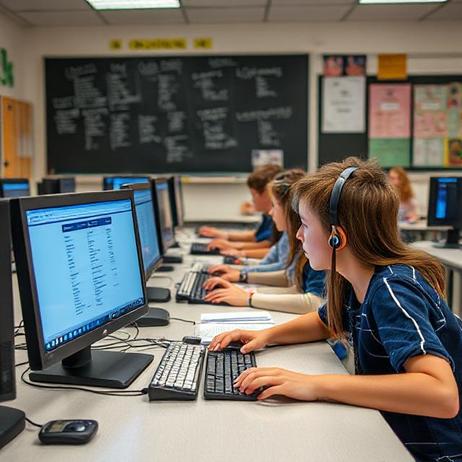Cybersecurity in U.S. Public Schools: 2025 Update
Introduction
In today’s digitally connected education environment, cybersecurity in public schools is now a core facet of school safety and operational integrity. As education systems across the country continue to adopt cloud tools, remote-learning platforms, and large student-data systems, the risk of malicious attacks, data breaches and operational disruption has grown significantly. This article refreshes our earlier discussion of cybersecurity in public schools with the most current data, policy developments and expert insights for 2025, offering practical guidance for parents, students and educators alike.
The Threat Landscape in 2025
The data is stark. A recent report by Center for Internet Security (CIS) found that 82 % of K-12 organizations experienced a cyber incident during an 18-month period ending in early 2025. Other research by the RAND Corporation found that across the 2023–2024 and 2024–2025 school years, 60 % of school principals reported at least one cyber incident in their school — including 45 % who cited business-email compromise or phishing. Another global-education-sector survey indicated that schools averaged 4,388 cyberattacks per organisation per week in Q2 2025, a +31 % year-over-year increase.
What does this look like on the ground? Schools report incidents ranging from phishing, ransomware, student or staff email compromise, to denial-of-service attacks and data breaches of student records. These attacks threaten student privacy, disrupt online learning and require costly remediation. For example, ransomware in the education sector often leads to encrypted systems, lost access to devices or cloud services, and steep recovery costs. CyberGlobal
Why Public Schools Are At Risk
Several intersecting factors make public schools particularly vulnerable:
Large volumes of sensitive data — Student records, staff information, finances and learning systems generate a rich target.
Fragmented IT ecosystems — Many school districts juggle legacy systems, mixed-vendor products, and variable budgets for IT security.
Limited cybersecurity staffing and resources — Smaller school IT teams often lack dedicated cyber incident response plans or full-time specialists. For instance, a 2025 survey found only 46 % of schools reported full multi-factor authentication (MFA) coverage across devices, and only 37 % had a dedicated cyber incident response plan.
Increased adoption of remote learning, cloud services and device fleets, which expand the attack surface and create more entry points into school networks.
Social engineering as a root cause — Human error, phishing scams, compromised credentials and vendor vulnerabilities remain among the highest-risk vectors.
Policy and Guidance Developments
In response to the rising threat, federal and state education agencies and cybersecurity bodies have moved to strengthen guidance, frameworks and requirements for schools.
The U.S. Department of Education (ED) still offers “K-12 Cybersecurity” resources aimed at helping schools adopt frameworks for prevention and resilience.
The Cybersecurity and Infrastructure Security Agency (CISA) issued “Cybersecurity Guidance for K-12 Technology Acquisitions,” instructing schools to prioritise “secure-by-design” software procurement practices.
At the state level, the Consortium for School Networking (CoSN) notes that in the 2024 session, 28 K-12 cybersecurity bills were introduced across 16 states, signaling growing legislative momentum.
Schools and districts are now adopting the national CYBER.ORG K-12 Cybersecurity Learning Standards, which lay out what students should know and be able to do in computing systems, digital citizenship and security. cyber.org
Key Programmatic and Budget Trends
Public school districts in 2025 are seeing the following trends in cybersecurity programming:
Increased investment in cyber hygiene — Districts are shifting funding toward MFA implementation, regular system patching, endpoint protection and backup strategies. In one article the emphasis on proactive hygiene was described as a must-have in 2025.
Growth of incident response and recovery planning — Recognising the inevitability of attacks, many schools are writing cyber incident response plans, engaging in table-top exercises and joining inter-district information sharing.
Emergence of student cybersecurity/cyber-career pathways — Schools are embedding cybersecurity awareness into curricula and offering Career & Technical Education (CTE) tracks in cyber for high-school students. niccs.cisa.gov
Vendor and procurement oversight — Schools increasingly scrutinise third-party software and cloud providers for secure-by-design features and require contractual assurances of data protection and breach notification.
State hybrid funding/mandates — Some states now tie cybersecurity training, incident reporting or minimum standards into their education funding or school-safety legislation.
Real-World Example
Consider the experience of a large urban public school district that was hit by a ransomware incident in early 2025. Because the district had not fully enabled MFA on its administrative login portals and its vendor had a weak credential set, attackers gained access, encrypted data, and demanded ransom. The district’s recovery forced them to shift to manual grading systems, lost several days of online instruction, notified thousands of student families and spent hundreds of thousands of dollars in incident response. This underscores two lessons: first, even well-resourced public schools face attack; and second, prevention (MFA, patching, vendor oversight) is far more cost-effective than recovery.
Best Practices for Public Schools
For schools, educators and administrators reviewing cybersecurity in public schools, the following priorities should form the backbone of any strategy in 2025:
Enable multi-factor authentication (MFA) across all administrator, vendor and student/staff accounts.
Maintain current patching and software update processes for all devices, endpoints and servers.
Develop a formal cyber incident response plan and conduct periodic drills or simulations. Schools should plan for ransomware, phishing and business-email-compromise scenarios.
Ensure regular data backups and secure offline copy storage. Many recent incidents involve encrypted backups or failure to recover due to lack of proper backups.
Adopt secure procurement practices requiring software and cloud vendors to demonstrate secure-by-design architecture, data encryption, vendor breach notification and least-privilege access controls. CISA
Train staff and students regularly on cybersecurity hygiene: recognising phishing, avoiding password reuse, locking devices when unattended, and reporting anomalies promptly.
Segment networks and restrict access privileges so that a compromised account cannot move laterally across the entire district network.
Monitor vendor risk and third-party access — Many school attacks originate via vendor systems rather than direct school servers.
Collaborate with state and federal resources such as the ED’s Safe Learning Environments resources, CISA’s K-12 toolkit, and local Fusion-centres or school district partnerships.
Inform and reassure parents — Transparent communication about cybersecurity risks and protective steps helps build trust and fosters community vigilance.
What Parents and Students Should Know
For parents and students anxious about cybersecurity in public schools, here are some practical tips:
Ask your school or district what protections are in place, such as MFA, backups and incident response.
Maintain strong personal cyber habits: use strong, unique passwords, enable MFA on any accounts you control, avoid sharing credentials and report suspicious emails.
Understand that student data is increasingly digital — grades, health records, contact information and more are stored online, so the risk of exposure is real.
Encourage your school to incorporate cybersecurity awareness into the curriculum: many students are now exposed to cyber-citizenship or digital-safety modules.
Inquire how the school protects third-party vendor access to student data, and what the policy is if a breach occurs.
Stay aware of updates: if your school or district issues a breach notification or cyber-alert, review it, ask questions and enable any recommended protections.
Looking Ahead
The cybersecurity threat to public schools is unlikely to abate. As states adopt generative-AI tools, increased connectivity and more devices per student, the attack surface grows. Schools must evolve from reactive models to proactive cyber resilience. According to predictions for 2025, education institutions will prioritise cyber hygiene, zero-trust architectures and continuous monitoring to slow the “target rich, cyber-poor” dynamic.
For those exploring other schooling options, such as boarding or private schools, cyber-resilience now forms part of institutional credibility. For example, when evaluating private or boarding schools for your child, you may want to ask how they handle cybersecurity, vendor access, data privacy and incident response planning. See more about boarding school safety standards at BoardingSchoolReview.com.
Conclusion
Cybersecurity is no longer a niche IT concern for public schools — it is central to school safety, student privacy and uninterrupted learning. With 82 % of K-12 organizations reporting incidents and attack volumes rising sharply in 2025, school leaders, IT teams, parents and students must act in concert. By adopting strengthened controls, investing in training, scrutinising vendors and promoting cyber-awareness, public schools can significantly reduce risk. For parents and students, asking the right questions and maintaining strong cyber-habits further supports a culture of digital safety. The road ahead is one of vigilance, resilience and proactive prevention.















